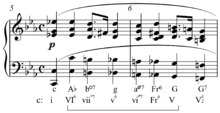
In music theory, a chromatic fourth, or passus duriusculus, [2] is a melody or melodic fragment spanning a perfect fourth with all or almost all chromatic intervals filled in ( chromatic line). The quintessential example is in D minor with the tonic and dominant notes as boundaries:
The chromatic fourth was first used in the madrigals of the 16th century.[ citation needed] The Latin term itself—"harsh" or "difficult" (duriusculus) "step" or "passage" (passus)—originates in Christoph Bernhard's 17th-century Tractatus compositionis augmentatus (1648–49), where it appears to refer to repeated melodic motion by semitone creating consecutive semitones. [2] The term may also relate to the pianto associated with weeping. [2] In the Baroque, Johann Sebastian Bach used it in his choral as well as his instrumental music, in the Well-Tempered Clavier, for example (the chromatic fourth is indicated by the red notes):
![\relative c'{
\key d \minor
\times 2/3 {[d16 e f]} \times 2/3 {[g f e]} \times 2/3 {[f g a]} \times 2/3 {[bes a g]}
a8 \override NoteHead.color = #red d cis c b bes a \override NoteHead.color = #black g ~ g f e a
}](https://upload.wikimedia.org/score/m/h/mhmidvin6nz01yvqoa9szpmymnq8nhx/mhmidvin.png)

This does not mean that the chromatic fourth was always used in a sorrowful or foreboding way, or that the boundaries should always be the tonic and dominant notes. One counterexample comes from the Minuet of Wolfgang Amadeus Mozart's String Quartet in G major, K. 387 (the chromatic fourths are conveniently bracketed by the slurs and set apart with note-to-note dynamics changes):

Musical works using the chromatic fourth or passus duriusculus

- Henry Purcell, "Dido's Lament" [2]
- Robert de Visée, Suite in C minor : Sarabande
- J. S. Bach, Mass in B minor, Crucifixus, also BWV 12, "Weinen, Klagen, Sorgen, Zagen"
- J. S. Bach, BWV 78: "Jesu, der du meine Seele"
- J. S. Bach, BWV 150: "Nach Dir, Herr, verlanget mich" (in the first choral, and a reverse, whole note upwards melody in the final Chaconne)
- J. S. Bach, Orgelbüchlein, BWV 614: "Das Alte Jahr vergangen ist" (in the three accompanying voices) ⓘ
- J. S. Bach, Invention No. 9 in F minor, BWV 795 (second subject)
- J. S. Bach, Prelude and Fugue in C-sharp minor, BWV 849, second voice in bar 69, soprano in bar 71
- J. S. Bach, Prelude and Fugue in E minor, BWV 855, fugue subject
- J. S. Bach, Prelude and Fugue in A minor, BWV 889, Prelude subject
- J. S. Bach, Prelude and Fugue in E minor, BWV 548, the widening chromatic character of the fugue subject lends the work the subtitle "The Wedge".
- J. S. Bach, Toccata in E minor, BWV 914, fugue subject
- W. A. Mozart, K. 594: "Stück für ein Orgelwerk in einer Uhr"
- Ludwig van Beethoven, Symphony No. 9, ending of first movement
- Frédéric Chopin, No. 20 from 24 Preludes, Op. 28
- Hector Berlioz, Requiem, Op. 5
- César Franck, Prelude, Chorale and Fugue
References
- ^ Benward, Bruce, and Marilyn Nadine Saker. 2009. Music in Theory and Practice, p.216. Eighth edition. 2 vols. + 2 CD sound discs. Boston: McGraw-Hill. ISBN 978-0-07-310188-0.
- ^ a b c d Monelle, Raymond (2000). The Sense of Music: Semiotic Essays, p.73. ISBN 978-0-691-05716-3.
- ^ Williams, Peter (1998). The Chromatic Fourth: During Four Centuries of Music, p.69. Oxford University Press. ISBN 0-19-816563-3.